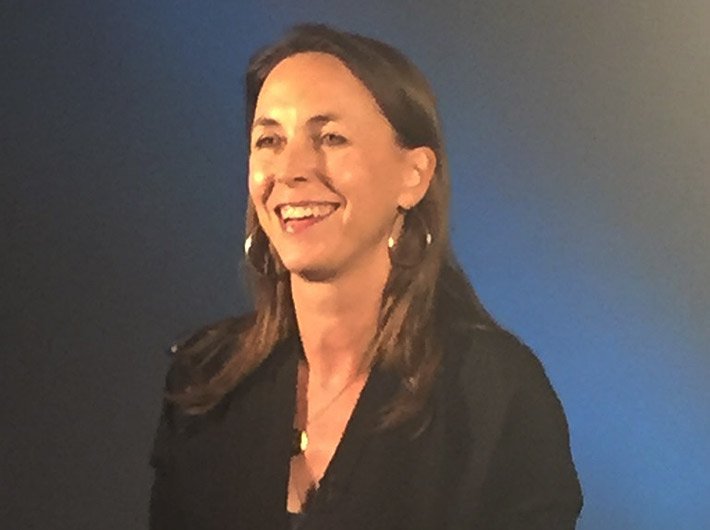Girl Rising campaign creator Martha Adams takes us through the journey of breaking barriers and empowering girls
Named one of the “125 Women of Impact’ by Newsweek/Daily Beast in 2013, Martha Adams is the chief creative officer of global Girl Rising Campaign. The organization has joined hands with prime minister Narendra Modi’s Beti Bachao, Beti Padhao Yojana. She is senior fellow at the University of Southern California’s Marshall Brittingham Social Enterprise lab which recognises leadership at the intersection of business and social impact. She serves as a film expert for the US Department of State diplomacy program American Film Showcase. Winner of National Emmy and New York Film Medals and Cine Awards, she was named ‘Humanitarian of the Year’ in 2015 by Novus. She spoke to Geetanjali Minhas on the Girl Rising campaign, importance of educating girls and breaking barriers to empower girls.
What is Girl Rising?
Girl Rising is a global campaign in support of girl’s education and girl’s empowerment. It began as a film- nine different stories nine girls from nine countries; each story tells how education played a profound role in their own liberation. We made that film because there are experts- global and non-profit leaders who understood correlation between educating a girl and progress of society but the masses do not know that. We made the film to elevate the powerful truth- to educate girls because when you educate girls, not only their families and communities become educated but the nation as whole progresses.
After the film came out we thought we are done and can pack our bags. But what happened around the world was astonishing. People from all countries started standing up and raising their voice about 62 million girls missing from classrooms. They wanted to help support their communities change. And that’s when everyone in Girl Rising thought that we had succeeded in raising awareness. Perhaps, this also could be really addressing the barriers that stand between the girls’ education and moving more from a campaign about raising awareness into a bonafide human rights movement.
We are using the Girl Rising campaign and all tools like social media, behind the scene videos, quotes and photography series. We are asking non-profit organisations if we can be of help in providing content for their programmes. We are giving it to global leaders asking them if they want to screen the Girl Rising chapter on child marriage and gender violence, and if this tool will allow them to lobby more effectively and change legislation. So whether it’s happening at the level of policy, non profits, schools, universities, churches or synagogues around the world, we are providing tools to people to change.
How is the response?
The response has been very diverse. We recently received a video from the principal of a remote school in Ghana who said they screened the film in school and made their own video where a village elder is telling a huge constellate of girls that they have a new weapon to fight for their freedom. It’s not a gun or a drone but its education and all of them rise up and start saying ‘girl rising, girl rising ’. That’s the response in a place where we have not yet distributed the film.
On a more organised level we received a grant from USAID to launch the film in three countries to see if we could partner with them. We began with India and formed an advisory board here and asked if they wanted the film. They said yes. They wanted to involve Bollywood stars and adapt it to Indian standards. Post its launch on August 29, 2015 on Star Plus and after meeting prime minister Narendra Modi we formed a partnership with the government.
We are also working in Congo and Northern Nigeria to see if its adaptation is successful in these areas of the world. If it is, then we hope is to launch Girl Rising in countries. We are getting a lot of support from Pakistan. Japan has started to build a base. We have received television offers from China and Peru.
Any challenges the project is facing at the moment?
Yes. We have a very serious bandwidth problem. We are constantly having to raise funds. When you go to a funder and say I need money to change minds, lot of times they scratch their heads and say I am not sure I need to think about that. We have a very small team, yet opportunities are pouring in and people want to get involved asking how they can contribute. It’s a movement now not just a campaign. The difficult task is how do you unite all of that, because when you unite, you scale up and you really see progress.
Also, fathers usually decide not to send their daughters to school because they are not comfortable that school does not have a female teacher or there are no bathrooms for their daughters to use or there is no safe passage. It’s not because they don’t want their daughters to lead empowered lives. And that’s an important distinction to make.
How difficult is it to reduce gender gaps in communities or bring about a change in mindset?
There are so many organisations around the world that are building schools, providing bicycles, paying fees for school uniforms. While all that is critically important the unique contribution that Girl Rising is making and focussing on is changing mindsets and recognising that unless you change perceptions and raise the value of the girls, those girls will not step across the threshold of school without their parents giving them the blessings to go to school. There is a lot of gender disparity in the world. It’s not like someone pointing a finger at another nation or a village. We are all in it together. One boy in Dharavi said to us, I am doing housework as a way of solidarity. There are many examples of fathers, brothers and uncles changing their mindsets and we have to tell their story so that their courageous acts do not remain isolated.
Why did the project premiere in India?
It originated in United States on CNN International and we moved to India next. India is one of the most popular countries in the world and powerhouse. It’s economically dynamic and a very important ally of the United States. It’s a place of dramatic change and shifting attitude. You also see here some of the greatest gender disparity in the world. I was in a community in Rajasthan near Alwar, where in 2002 there were no girls in school at all. I was told by a village elder that till as recently as 2012 they did not support girl’s education.
So our work in India not just a mass media campaign abut we are also launching community engagement and mobilisation programme. We are focussing on Bihar and Rajasthan where we are working in partnership with Save The Children and ibtada (NGO). The Indian diaspora in US is very involved in technology and social change and has been supporting Girl Rising right from start. Recently in Washington DC we just has a big gala- The Global India Fund for 860 guests and it was hosted by Freida Pinto.
You have earlier investigated human right abuses- what kinds of human rights violations are plaguing the developing world?
I think two most important issues are gender violence and child marriage. Though many issues are happening simultaneously, intersecting and complicated in many ways but we certainly see gender violence happening everywhere whether it is United States, Cairo or here in Mumbai. It is pervasive. Fifty percent of cases of sexual violence are happening with girls under age 15.
Any special memories while filming Girl Rising?
So many. In India I interviewed hundreds of girls while locating candidates, for filming. There is one girl I met here in Mumbai at the basement of the Taj hotel and I want to track her down. She was sold by her mother to a handler who then sold her to a brothel at age 13. Alternately she was rescued and sent to a shelter here in Mumbai and eventually she joined a training programme at the Taj Hotel to become a maid. I was so taken by how a child can be enslaved and treated worse than an animal, could learn how to read and write English and becomes this very empowered young lady. My hope is to find her and see how she is doing.
What are the plans next?
To ensure the success of Girl Rising in India and inspire citizens across India to tell their story. Step forward and post their testimonials of their own stories on YouTube and to find all those creative people who are changing their communities. If more and more people step forward to tell their stories change will happen much faster. Once girls in Mumbai can talk to girls in Bahrain and girls in Bahrain can talk to girls in San Francisco, they will know that they are not alone and can share their stories and find ways to improve their lives, we will start to see the no. of 62 million girls who have not seen classrooms drop.

